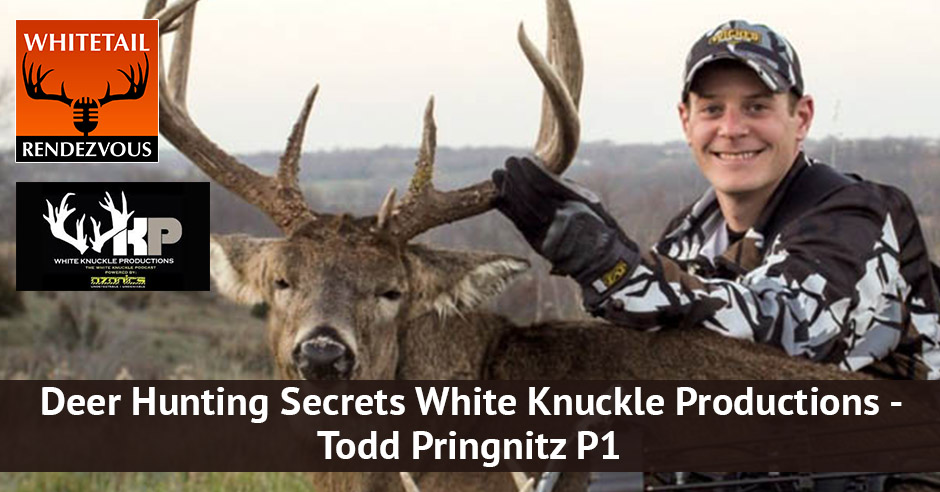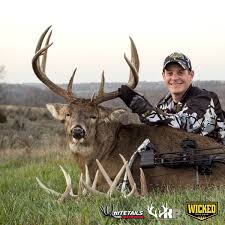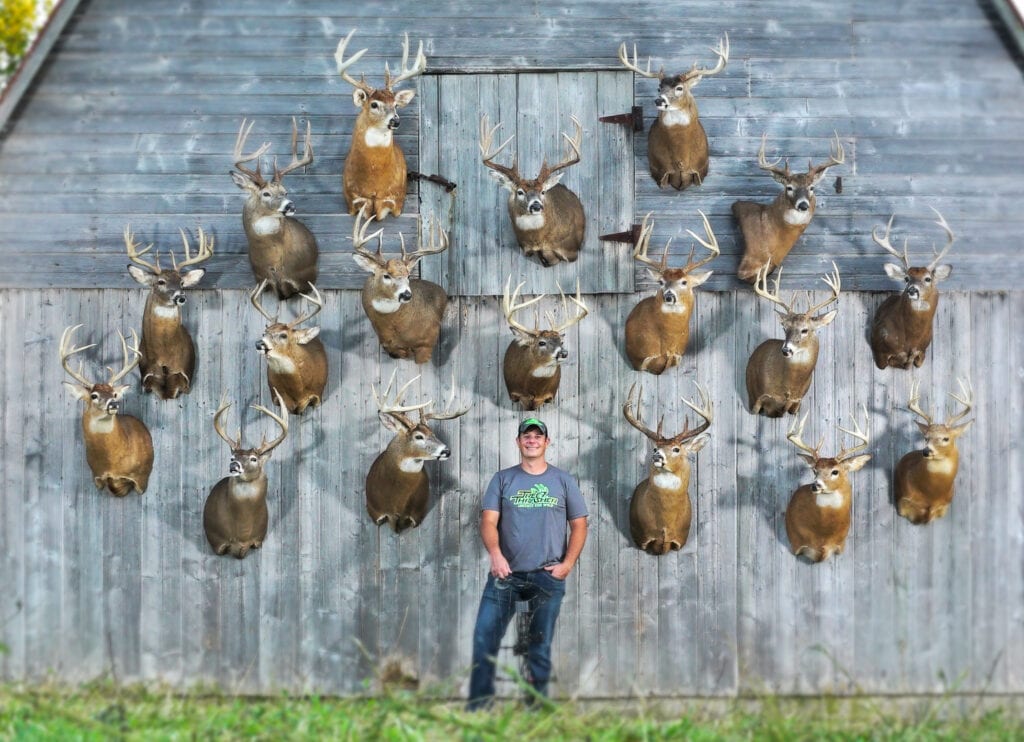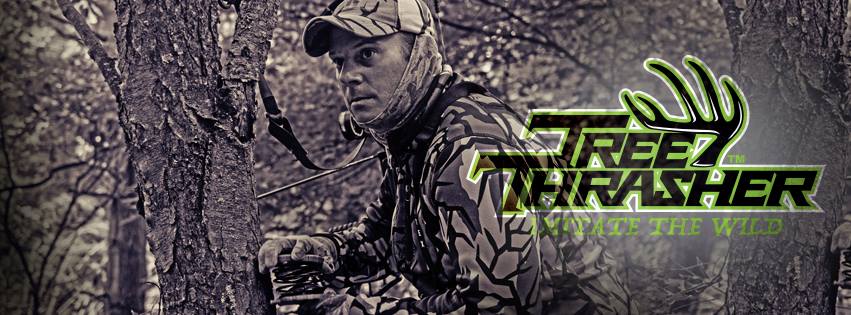
If you master the technique of calling, then you would definitely pull a buck into range. Today’s guest just called a 160-inch eight-pointer seven-year-old deer in a ground blind situation using one brilliant tool. Todd Pringnitz, the Founder of White Knuckle Productions, reveals the most effective calling strategy that he tried and tested in his hunts and undoubtedly served its purpose. As he tells why “rattling” doesn’t work as well, find out the details about this fantastic tool he built and his grunting procedure in this special edition.
—
Listen to the podcast here:
Deer Hunting Secrets White Knuckle Productions – Todd Pringnitz P1

Todd, it’s great to be back. You were on the show way back. This is a warm-up. Todd and I are going to catch up a little bit here before we get into the episode about White Knuckle Productions. Todd, what’s been going on since the last few years?
It’s been crazy. We sold one business and starting a new business. I’m between hunting, property management and family life. It’s been a blur, to be honest. I’ve been working hard on a new company and hunt whitetails. It never ends. I had the best whitetail season in my life. I killed three different seven-year-old whitetails, two with a bow and one with a muzzleloader. It’s a dream season I’ll never duplicate again.
I rolled my truck north of Eau Claire, Wisconsin. I never hunt it. It walked away. I walked up to the hill. I just crossed the tip of the river and I was heading up to Rice Lake, actually Birchwood to my buddy’s farm. We had a wonderful ten-pounder on the camera. He was big. It was a big mature deer. It’s everything you’d want. We had a strategy, we’d go hunt him. He had guys that knew how to hunt. One of us should have had a shot. I never made it.
I’m glad you’re okay. That’s scary.
It was scary. I hit black ice. I wasn’t cited for anything. The highway patrol said, “There was nothing you could do.” You hit it, your back end went, and you were gone. We’re glad we’re walking out of here.
If you’ve missed your hunt, you can catch up later in life. Share on XYou missed your hunt, but you can catch up later in life.
Wherever you’re going, be smart and be safe out there. I tell that to everybody because there was nothing I can do. I did the NASCAR, folded my arms over my chest and said, “Just wrote it out.”
I’m glad you’re okay. Black ice is dangerously scary. In regard to safety, it’s the one thing I always add in any conversation, especially this time of the year with any hunters. Make sure you wear your safety harnesses. If you can, use lifelines in your tree stands because it can happen fast. We’re all in a big hurry to try to get up on our tree stands and be ready for that big buck when it comes through or whatever. You can’t take enough time to be safe.
 I’m hunting from the ground. I don’t know if I’ll get up even to a double ladder. I’ll just hunt from the ground, which is fine. I had a little epiphany. I’ve always been a believer in God and I was like, “Why did you save me?” You had your dream season. How long ago did you start White Knuckle Productions?
I’m hunting from the ground. I don’t know if I’ll get up even to a double ladder. I’ll just hunt from the ground, which is fine. I had a little epiphany. I’ve always been a believer in God and I was like, “Why did you save me?” You had your dream season. How long ago did you start White Knuckle Productions?
This is our twelfth year.
You were doing that when you had the other company, Wicked Tree?
I started White Knuckle back in the day. We were selling DVDs. We produced about ten DVDs over a few years and about a few years ago we stopped producing DVDs with the way the web is and everything has shifted. We just do a web show and a podcast now. I’m a whitetail machine. That’s what I was born to do. It’s been fun to use the new technology. Even right now, I downloaded this app that we’re talking on right now. It’s amazing what we have out there. It changed so quickly. I know we started out doing DVDs and I’m facing the web stuff, but we’ve never looked at White Knuckle Productions of being a moneymaking business. It’s a business of passion and it helps support the companies that we work with, our sponsors, as well as my companies that I produce a variety of products with.
We’re able to keep it a little bit more down to earth and raw and it’s not an infomercial. We share our stories as they happen in a unique way. It’s far more relatable for any whitetail hunter. You don’t have to be crazy serious on that. We’re all a bunch of nuts. There’s a lot of great information and great people and we kill some world-class whitetails every year. This past season, I was able to kill a buck of about 190 class. That is the biggest typical frame of whitetail I’ve ever seen in the woods. It was absolutely insane. We got everything on video. We just released the story and it has been blowing up.
What are the other businesses you’re involved in?
If your system is not working, you need to change your system. Share on XThe new one I just started is called Tree Thrasher. It’s a new kind of call. I know when people hear the beginning of the new product stuff, especially when it comes to new calls, they’re thinking, “What gimmick is this?” I’ve been hunting here in Iowa for a long time and I’ve hunted some properties that were unpressured and unbelievable. You can rattle there throughout the season. It was amazing. The deer had no pressure and they weren’t educated by other hunters. When I bought my farm at a different location here, I had a lot more hunting pressure on me. Over the part of the first season that I was hunting here, I realized, “There are a lot of guys around and they’re calling aggressively.” I would listen to one neighbor rattle, cam call, grunt and bleep for their entire hunt on one side of my property. I’d go to the other side and listen to a different neighbor. I had three different encounters in a matter of a few days and I was like, “No wonder rattling doesn’t work here.” I’ve never been able to rattle in any mature bucks. A light bulb went off like, “Now I know why they’re not calling too aggressive callings. I had to change my calling strategy because I was not calling in these big mature seven-year-old deer that were on camera. I started figuring out and I was like, “They must have my number.”
That’s like elk coming out here in Colorado when they started the diaphragm turkey call. What I do is I’ll call at 3:00 or 4:00 in the morning for locator and all the rest is estrous calls and a muse. I call in more people every year than I call an elk. Except if they walk in and they get an arrow nock.

I came to a conclusion like, “My system is not working, so I need to change my system.” It took me to stop carrying my rattling antlers because if I brought him along, I’d be tempted and sure enough, I’d end up using them. What happens with rattling is these deer can hear it from hundreds and hundreds of yards. The problem with rattling is you can’t duplicate the sound of a real big buck fight. In 30 years of hunting, I’ve heard one big buck fight in the timber in my life. We have the whole thing on video. We couldn’t see the bucks fighting, but we can hear them. When it started, I didn’t know what it was. I was like, “What is my neighbor doing? Are they driving a truck through the woods?” That’s what it sounded like, thrashing trees, breaking branches, and thunderous noise of two monster animals pushing each other around the timber. You can barely even hear the antler. You could just hear the crashing of timber.
Everything came running to that sound. My cameraman and I are up in the tree stand cheering like, “This is unbelievable. This is incredible.” They knew it was real because it sounded real and it worked. Everything came in. They wanted to see what bucks were fighting. The does and fawns too couldn’t believe it. They came from all directions and we were in a good area. They vetted around us and we were filming a beautiful four-year-old buck we called Tuna Fish. He had come in and vetted by us. We were thrown and vetted down. The fight broke out. He jumped right up, stood up and ran right to it. The problem with rattling is you can’t duplicate those other noises. If you’re up in a tree making the click rattle, I can hear the difference. I don’t live in the woods and I don’t live and die by my senses. Imagine the way of whitetail buck when he’s lying in his bed and he hears this clickety click and then 20 to 30 minutes later, here’s the same sound coming from the same location. He knows exactly what you are and you will just not see that deer.
A lot of guys have been calling in the same tree stands year after year with the same calling methods. I believe the deer learn a lot of their instincts and their knowledge from their mother the first year of their life. They follow her around, imitating her actions, reactions, what she does, what she eats and what she’s afraid of. You can imagine a buck when he’s one-year-old or two years old. He separates from mama, goes and starts living with other bucks. He’s imitating the head buck or the alpha buck or the dominant deer in those bachelor groups. These deer are learning from generation after generation of animals. That instinct is pounded into their behaviors. If you’re hunting a five-year-old deer, it’s not just five years of knowledge that the buck is carrying or possessing. They carry many generations of knowledge. If you have many generations of hunters that have been hunting the same way in your property with the same ladder stand or whatever it is, the deer will pattern you. As soon as you start making those calls from those same locations, they know what it is and you won’t see him.
What I found in my few years and 500 episodes is that your first three sets are your best sets. You never sit the same stand in the series of three in any one year. The guys that are doing that are extremely successful because they don’t pattern them. They run and gun and they move their stand. They’re using the hang-up and even double ladders or ground blind that they can move. I’ve got to the point that I’m able to hunt on the number of states and I’m going to hunt in threes. I’m going to use my ground blind and hunt in threes and see what happens. It’s going to be an interesting experience because of that. If you’ve been hunting the buck master stands for year after year because you shot during rifle season, you’re calling sequence doesn’t change because we all have our own voice. When I elk hunt, I have my own voice. When I call coyotes, I have my own voice. When I call deer, I have my own voice. We all have our own voice. It doesn’t sound like tape. You have to minimize that and do it at the right time. I’m going to talk about the right time to rattle because sometimes you can rattle and it doesn’t work. Have you found that to be true? Not because of pressure.
Deer learn a lot of their instinct and their knowledge from their mother the first year of their life. Share on XI’ll tell you why rattling doesn’t work. Everything is based on goals. My goal is to kill the bucks that are six or seven years old that nobody else can kill around me. If my goal was to kill any buck, I would change my calling strategy. Those big ones have been around the block in order for them to survive to five to seven years. If they were to come to the calling, they would have died years before. For them to make it to that age, they’ve already survived the gauntlet of hunters around. They’re already very call-shy. They’re not coming in. Their personalities are not aggressive, otherwise, they would be dead. It’s a forced evolution what I call it. I’ve had to change my system to these mature deer. If your goal is to kill these bucks, you have to start from ground zero when it comes to calling if you have not been calling them in the past.
I came to a conclusion many years ago that rattling scared more deer than it attracted so I quit rattling. Around that time, I started to see some of these big mature bucks. A big mature deer walking around during daylight or during hunting season is a pretty rare situation. There are huge farms that the deer are comfortable and they are up moving around. For the rest of us, big bucks don’t move that much during daylight. You’re trying to recreate a scenario of two big bucks that are up on their feet moving around during daylight and they happened to meet in a fight. That is such a rare occasion that in 30 years, I’ve heard it once. I hunt a hundred different sets a year of whitetail hunting. I’ve been doing it for several years and I’m hunting full-time and I’ve only heard one real big buck fight.
When you start rattling, that’s a very rare occurrence. There are not a lot of big buck fights out there. If you’re trying to kill that old mature buck, he doesn’t care about two little bucks clicking their antlers together. That’s not going to call him in. What gets under his skin is a dominance thing that somebody has invaded his territory and that’s what you’re doing. You’re trying to piss off a buck when you rattle and it doesn’t. The other sounds aren’t there that you’re just not going to dupe them. That’s where I started grunting and not more than a single time in a row in cadence. I don’t know where it came from, but everybody grunts their time. That’s how I was taught. I came to a conclusion that that’s not even realistic because a buck doesn’t stand in one location and grunts continuously. It usually will grunt once and that’s about it. Occasionally, you’ll hear them grunt multiple times, but it’s always when they’re moving through the timber.
What about a tending grunt?

I don’t believe in all these different varieties of calls and all of these grunts. You better be running through the woods when you do it because otherwise, it’s not going to sound natural. You’ve got to have the other noise because the deer are always chasing. You’re always going to have the leaves and breaking branches and all that stuff. I came to a conclusion for the bucks I was hunting, one grunt every 20 to 30 minutes and I always change it up. Every single grunt is different. I use a grunt tube on one call and on the next call I’ll use my voice. I always project it in a different direction so it sounds like a different deer in a different situation. No two grunts are the same so why do you sound the same with every grunt?
The Tree Thrasher product came from necessity. I’d be sitting on the edge of these buck bedding areas in stands that I don’t hunt more than a couple of times a year. You spent all the time and energy getting those stands ready. In some cases, I spend ten to twelve hours on a stand, which is hard for some people to believe. By the time you caught access trails or mark access trails, hang your stand and turn them for self-filming. I’ve got to have good lanes so I put a lot of time in these spots. When I’m in there hunting and I’m sitting there, and I know a buck could be better within a hundred yards and my grunt strategy hasn’t been working and it’s starting to get dark, there’s no frustration like it. You know that there is a possibility you could call one out, you just don’t have a tool to do it. What I started doing over the years was using my rattling antlers. I’m bringing one antler and rubbing it on a tree trying to create sounds that accompany a real animal moving through the timber, acting like a buck in the timber thrashing trees and breaking branches.
There was nothing available so I came into my brain. I was like, “If you could create a tool that created the sound of rustling leaves, breaking branches, and a sound of buck on a tree and be able to use those sounds individually or together and accompany that with a single grunt, it would work,” because it sounds natural. That’s what a buck sounds like. A buck doesn’t sound like grunting and standing on one location and not moving. Usually, when they’re making an audible intentional loud noise, it’s because they feel comfortable. They feel safe in the area they’re in. They’re not going to be thrashing a tree and making all sorts of racket if they think a hunter is right there, but that sends a signal. It’s a form of communication that whitetails have. If they hear that noise of another animal making an intentional noise, they know it’s safe over there. Sure enough, it becomes a hub of activity. They want to come and see what’s going on over there. What’s the ruckus about?
Is that data testing? How do we get one to take the four states in hunting?
We’re in production. We’re going to get our first shipment. I realized that if I could create a little bit of extra noise with a tending grunt or a buck grunt before or after some of these noises, I believe that it could increase the number of deer I would call it. It’s not some magic tool or some magic formula. It’s just manipulating whitetails. I’ve successfully manipulated big bucks out of their beds and brought him right past my stand with my grunting procedures over the years. Big bucks are like cats. I would never have considered myself a cat person, but we have a cat. My wife brought it home, it was forced on me, and now I love the little guy. After watching cats and getting to know these things, cats have attitudes and so do big bucks. They have attitudes. When you’re calling these big old deer, they’ve heard it all and they’ve seen it all. You’ve got to reach them instinctually and aggravate them. That’s how I describe my calling processes.
If there’s a deer bedded within earshot of me, I want to pick at them throughout an entire hunt and aggravate them to the point where they don’t have a choice. They are going to get up, come and investigate because it drives them crazy, but you can’t do that with over calling. With a cat, it’s the same thing. If you try to force a cat to come to you or to do something, they’re going to look the other way. If you tease them, here they come. It’s the same principle. You’ve got to work these bucks, but you’re doing it in a way no other hunter before has done. I am set in a situation and I pretend I’m a deer or part of the herd. If I’m a buck, I’ll walk up to a tree.
Are you in your tree stand when you’re doing this?
I use a ground blind. I use one of my big 168-pointer, seven-year-old deer called it with my Tree Thrasher in a ground blind situation. They work excellent on ground blinds because you don’t have to worry about any of your movement. You have to see the tool. It’s very small, compact, but you can make a branch breaking noise and leaves noise together. The tool itself you can rub on the tree so you can layer those different tones and use them individually based on what your situation is. Every stand is different and every hunt is different. The noise level in each state is different depending on how dry the leaves are. There have been many times where I’ve been on an excellent spot. It’s been dead quiet and the leaves are dry. If I call at all, anything that’s within hearing distance, they’ll know I’m a hunter because they don’t hear the other sounds.

They don’t hear the sound of an animal walking around and then the grunt. You just got to think of it from that standpoint. All the truth that it does for me is it allows me to use a grunt call and my thrash noises. If a whitetail hears those two things, it increases the number of deer that come past my stand. I’ve used it dozens and dozens of times on a bunch of hunts and what is amazing is does are extremely attracted to the sound. I found myself that if I’m making these thrashing noises accompanying it with a grunt within five to ten minutes, I would have a doe within twenty yards of my blinder stand. Instinctually, they’re driven to that sound. They’re very curious about what is that. What’s the animal doing over there? Do I need to be over there? Is the food over there? Is there another deer over there? It’s a social thing, but it works and it’s amazing.
This was a warm-up from White Knuckle Productions and it turned into a special edition.
Important Links:
About Todd Pringnitz
 CEO, Todd Pringnitz has been hooked on bowhunting ever since his first morning on-stand. Nearly 18 years later, Todd’s passion for bowhunting continues to evolve and grow with every new season and new business ventures within the hunting industry. It was Todd’s goal to create a hunting production that would appeal to the do-it-yourself hunter, who was ready for a fresh approach on the very traditional hunting video.
CEO, Todd Pringnitz has been hooked on bowhunting ever since his first morning on-stand. Nearly 18 years later, Todd’s passion for bowhunting continues to evolve and grow with every new season and new business ventures within the hunting industry. It was Todd’s goal to create a hunting production that would appeal to the do-it-yourself hunter, who was ready for a fresh approach on the very traditional hunting video.
Todd’s straight-forward attitude and outgoing personality have allowed him to define who he is both as a person and as hunter like no other professional hunter before him. Todd’s approach is direct, aggressive, and different than what has ever been shown on-film. The goal was simple; show everything behind a kill – this is the White Knuckle difference!
